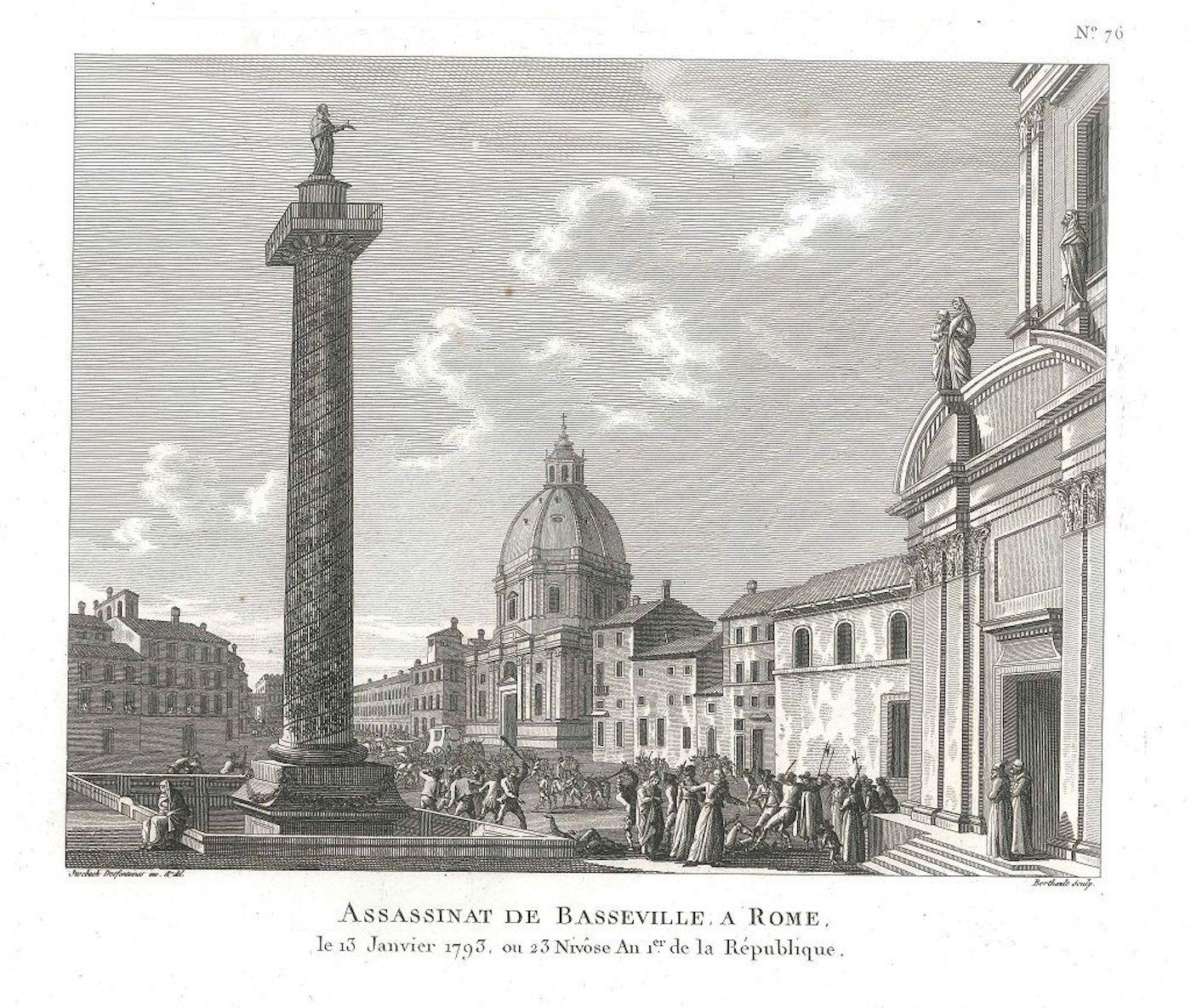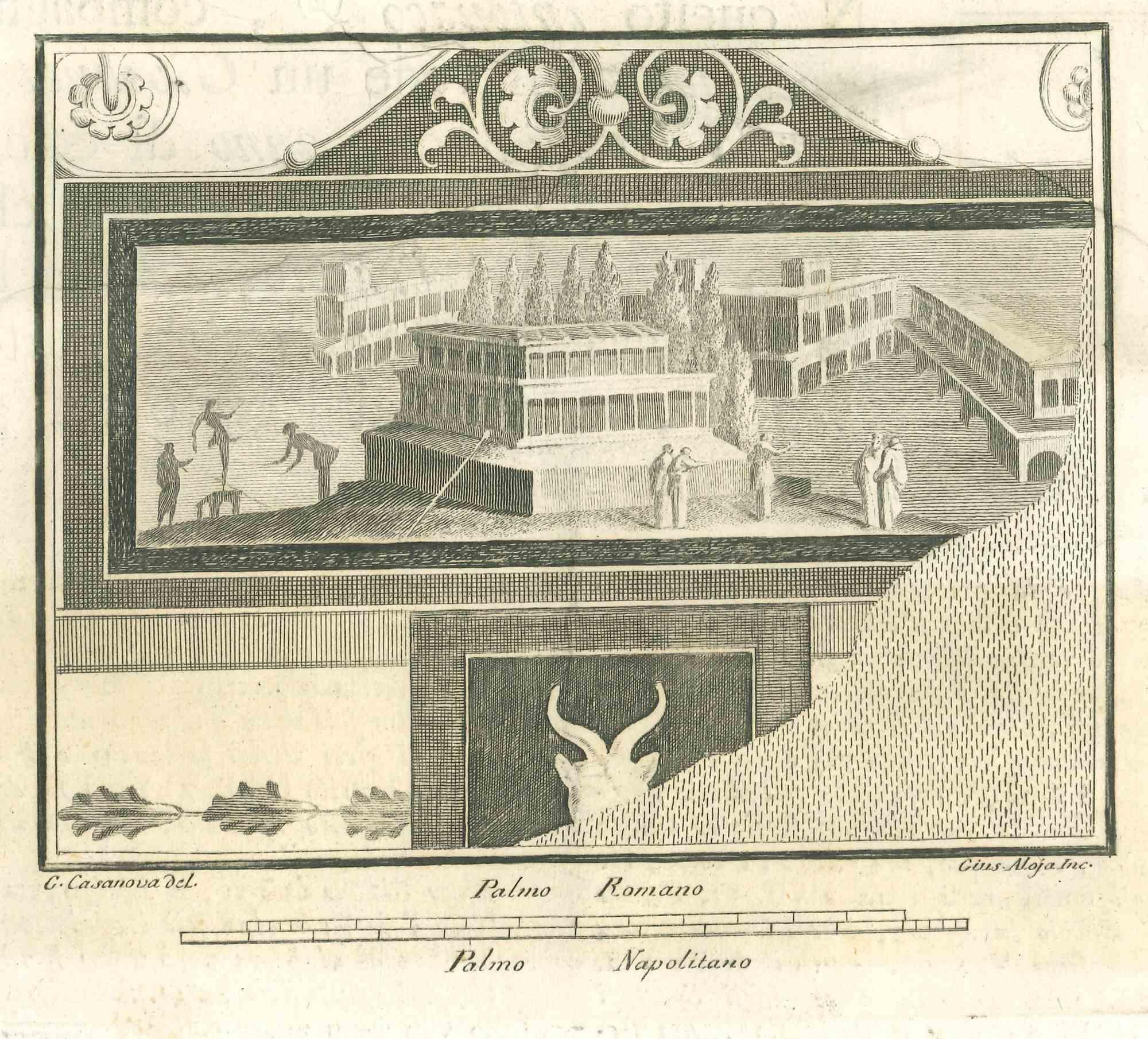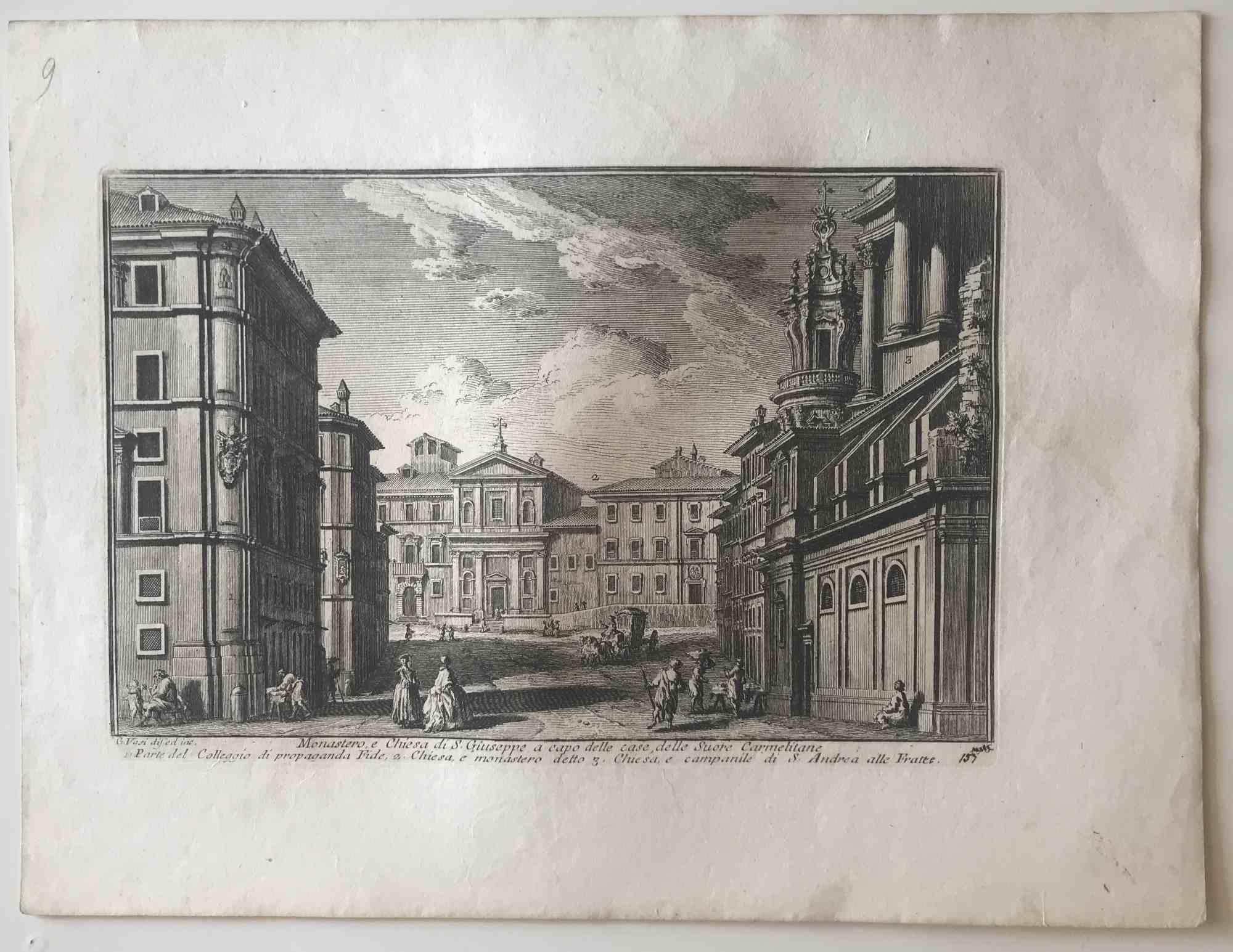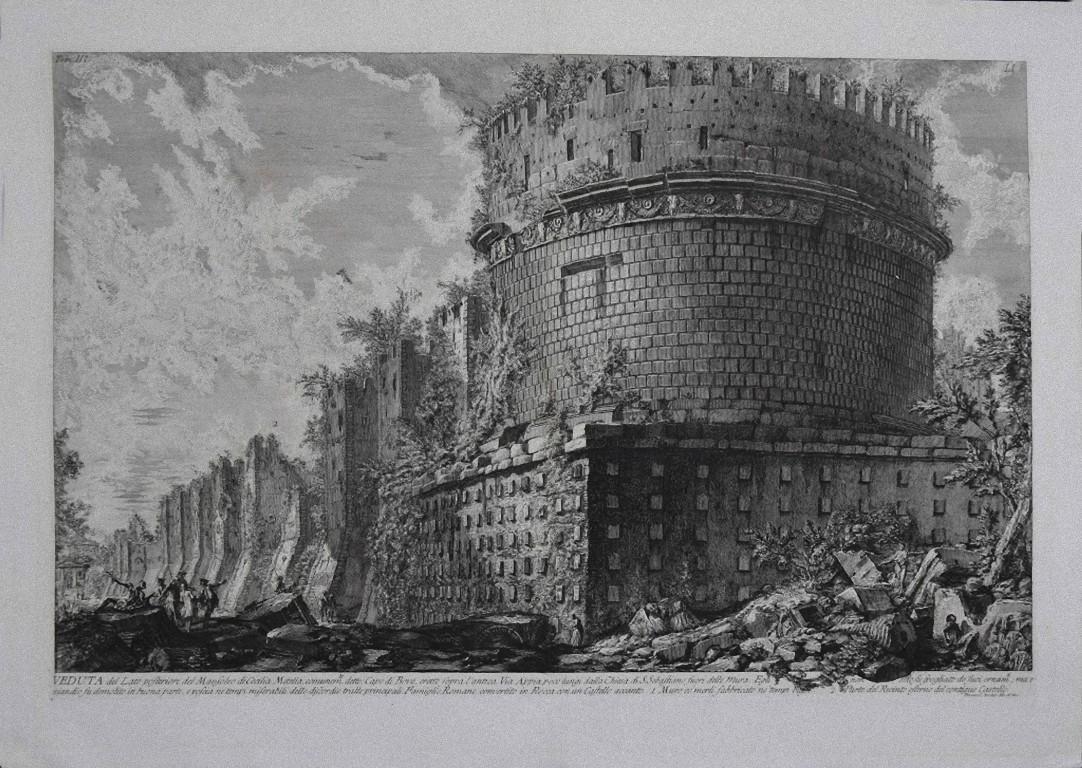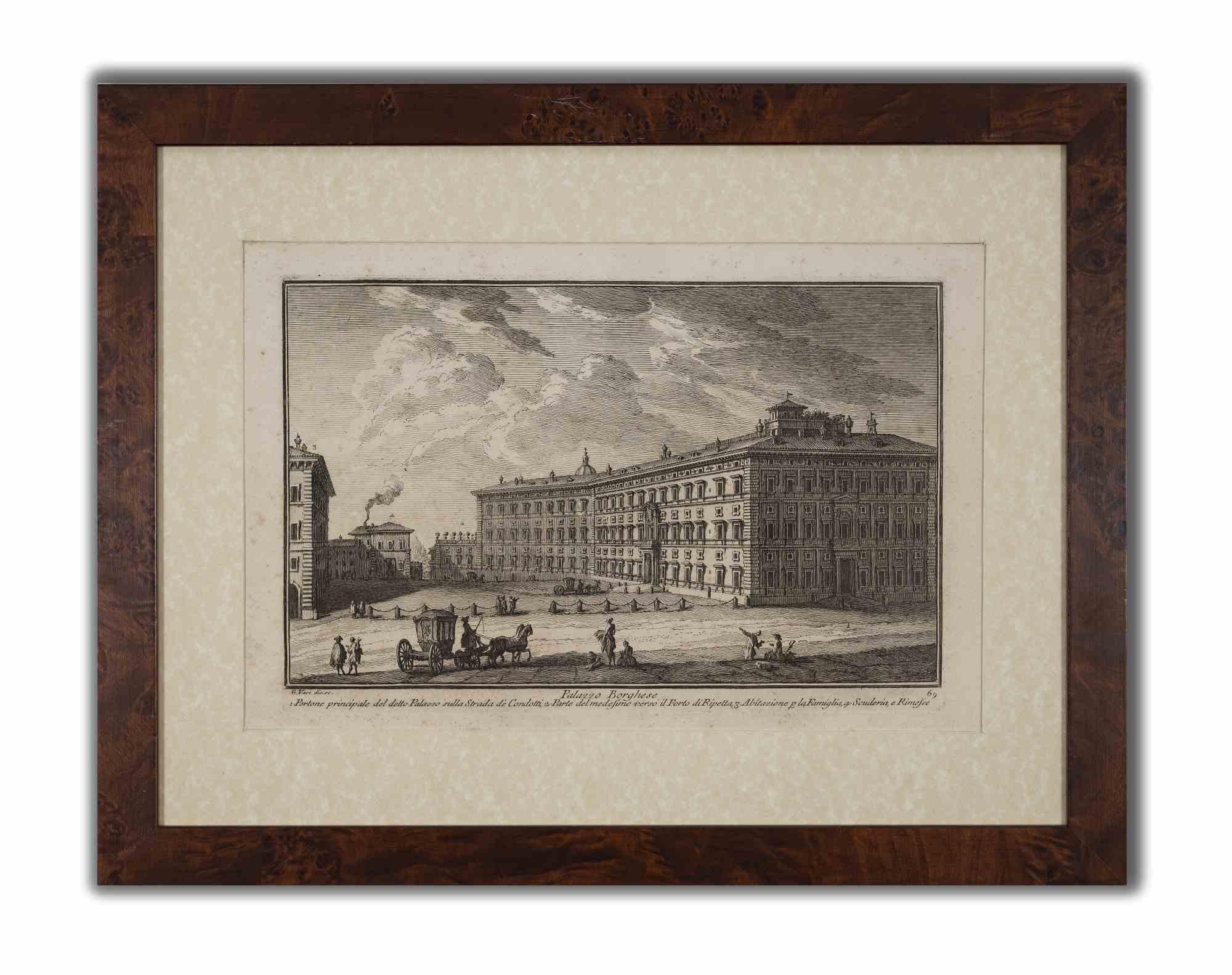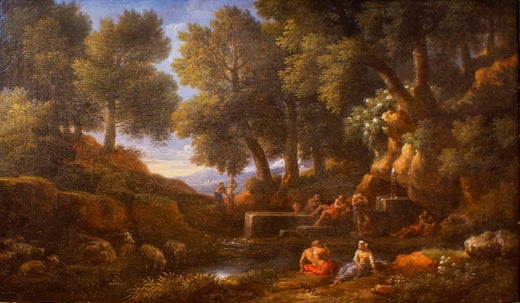Items Similar to 17th century etching black and white figurative landscape cityscape buildings
Want more images or videos?
Request additional images or videos from the seller
1 of 8
Jan Frans van Bloemen (Orizzonte) 17th century etching black and white figurative landscape cityscape buildings1670-1746
1670-1746
About the Item
"Figures Outside the Monastery" is an original etching by Jan Frans van Bloemen. It depicts people on the path to a church.
7" x 10 1/4" art
19 1/4" x 22 5/8" frame
Jan Frans van Bloemen (baptized 12 May 1662 - buried 13 June 1749) was a Flemish landscape painter mainly active in Rome. Here he was able to establish himself as the leading painter of views (vedute) of the Roman countryside depicted in the aesthetic of the classical landscape tradition.
Van Bloemen predominantly painted classical landscapes, taking his inspiration from the Roman Campagna. His landscapes, with their recession through a series of planes, soft, warm lightning and classical and religious subject matter, drew on the examples of artists such as Claude Lorrain and Gaspard Dughet. His paintings are exquisitely imbued with that "difficult-to-define pastoral ambience" which helped to make him such a great painter in the eyes of his contemporaries. The technique and subjects of the work of Jan Frans van Bloemen are also related to painters such as Jan Asselijn, Thomas Wyck, Willem Romeyn and Willem Schellinks. His painted vedute fall into the category of the vedute that combine reality with imaginary elements.
His landscapes have an Arcadian lushness, with mountains, streams, distant hamlets, and small inhabitants painted with imprecise pittura di tocco ('painting of touch') using small dotting and spirited brush-strokes. Unlike van Wittel, van Bloemen did not generally depict views of areas distant from Rome such as the Tiber valley or the Alban hills. His subjects were limited to views in the immediate vicinity of Rome, an outline of which was typically visible in his compositions. Van Bloemen was in particular known for his 'estate views' representing the estates of the nobility in the Roman Campagna. His views aim to associate the modern estate view with the classical arcadian landscape. Rather than offering the wide panoramic views, distant horizon and atmospheric effects associated with topographical landscapes, van Bloemen's estate views emphasize minute observation of reality and a limited viewpoint. The estates are thus made to appear as immutable features of the local landscape.
He worked together with other painters who painted the figures in his landscapes such as Carlo Maratti, Placido Costanzi and Pompeo Batoni. However, he only relied on such collaboration with figure painters in the last decades of his life when he produced his most ambitious classicising compositions. Even then he only relied on these figure specialists for the most prominent figures in the foreground while he took care of the minor characters. In fact, van Bloemen was an accomplished staffage painter and he was very skilled at quickly learning to imitate the style of his collaborators. As a result, many of the figures in his paintings that are attributed to prestigious contemporaries were actually by his own hand. He collaborated most frequently with Placido Costanzi. He regarded the pair of paintings representing The Flight to Egypt and The Rest on the Flight to Egypt as his best collaboration with Placido Costanzi who painted the figures.
His landscape drawings, which often depict imaginary ruins, have been confused with those of his brother Pieter, who is better known for his drawings of figures and animals. Jan Frans van Bloemen also made pen drawings of buildings in and around Rome.
- Creator:Jan Frans van Bloemen (Orizzonte) (1662-1749, Flemish)
- Creation Year:1670-1746
- Dimensions:Height: 19.25 in (48.9 cm)Width: 22.625 in (57.47 cm)
- Medium:
- Movement & Style:
- Period:
- Condition:
- Gallery Location:Milwaukee, WI
- Reference Number:
Jan Frans van Bloemen (Orizzonte)
Jan Frans van Bloemen (baptized 12 May 1662 - buried 13 June 1749) was a Flemish landscape painter mainly active in Rome. Here he was able to establish himself as the leading painter of views (vedute) of the Roman countryside depicted in the aesthetic of the classical landscape tradition. Van Bloemen predominantly painted classical landscapes, taking his inspiration from the Roman Campagna. His landscapes, with their recession through a series of planes, soft, warm lightning and classical and religious subject matter, drew on the examples of artists such as Claude Lorrain and Gaspard Dughet. His paintings are exquisitely imbued with that "difficult-to-define pastoral ambience" which helped to make him such a great painter in the eyes of his contemporaries. The technique and subjects of the work of Jan Frans van Bloemen are also related to painters such as Jan Asselijn, Thomas Wyck, Willem Romeyn and Willem Schellinks. His painted vedute fall into the category of the vedute that combine reality with imaginary elements. His landscapes have an Arcadian lushness, with mountains, streams, distant hamlets, and small inhabitants painted with imprecise pittura di tocco ('painting of touch') using small dotting and spirited brush-strokes. Unlike van Wittel, van Bloemen did not generally depict views of areas distant from Rome such as the Tiber valley or the Alban hills. His subjects were limited to views in the immediate vicinity of Rome, an outline of which was typically visible in his compositions. Van Bloemen was in particular known for his 'estate views' representing the estates of the nobility in the Roman Campagna. His views aim to associate the modern estate view with the classical arcadian landscape. Rather than offering the wide panoramic views, distant horizon and atmospheric effects associated with topographical landscapes, van Bloemen's estate views emphasize minute observation of reality and a limited viewpoint. The estates are thus made to appear as immutable features of the local landscape. He worked together with other painters who painted the figures in his landscapes such as Carlo Maratti, Placido Costanzi and Pompeo Batoni. However, he only relied on such collaboration with figure painters in the last decades of his life when he produced his most ambitious classicising compositions. Even then he only relied on these figure specialists for the most prominent figures in the foreground while he took care of the minor characters. In fact, van Bloemen was an accomplished staffage painter and he was very skilled at quickly learning to imitate the style of his collaborators. As a result, many of the figures in his paintings that are attributed to prestigious contemporaries were actually by his own hand. His landscape drawings, which often depict imaginary ruins, have been confused with those of his brother Pieter, who is better known for his drawings of figures and animals. Jan Frans van Bloemen also made pen drawings of buildings in and around Rome.
About the Seller
4.9
Platinum Seller
These expertly vetted sellers are 1stDibs' most experienced sellers and are rated highest by our customers.
Established in 1966
1stDibs seller since 2017
392 sales on 1stDibs
Typical response time: 1 hour
- ShippingRetrieving quote...Ships From: Milwaukee, WI
- Return PolicyA return for this item may be initiated within 14 days of delivery.
More From This SellerView All
- 17th century etching black and white landscape forest trees satyr goats signedBy Giovanni Benedetto CastiglioneLocated in Milwaukee, WI"Mythological Scene--Satyr & Goat Herder" is an original etching signed by Italian artist Giovanni Benedetto Castiglione. It depicts a satyr lounging on the left and an approaching g...Category
Mid-17th Century Old Masters Landscape Prints
MaterialsEtching
- 17th century etching black and white landscape forest trees figures sceneBy Claude LorrainLocated in Milwaukee, WI"Le Patre et la Bergere (The Herdsman & Shepherdess)" is an etching by Claude Gellee (Le Lorrain). This etching is in the collections of the Metropolitan Museum and the British Museu...Category
Mid-17th Century Old Masters Landscape Prints
MaterialsEtching
- 17th century etching black and white landscape scene forest trees goatsBy Claude LorrainLocated in Milwaukee, WI"Les Chevres (The Goats)" is an original etching by Claude Lorrain. It depicts two pairs of goats and a shepherd watching over them. This etching is also in the collections of the Me...Category
1630s Old Masters Animal Prints
MaterialsEtching
- 17th century etching black and white landscape forest trees river figures sceneBy Claude LorrainLocated in Milwaukee, WI"Le Point de Bois (Rebecca & Eliezer)" is an etching by Claude Gellee (Le Lorrain). This etching is in the collections of the Metropolitan Museum and the Louvre. Publisher: Mannocci ...Category
Mid-17th Century Old Masters Landscape Prints
MaterialsEtching
- 17th century etching black and white landscape forest trees river sceneBy Claude LorrainLocated in Milwaukee, WI"L'Apparition (The Vision)" is an original etching by Claude Lorrain (Claude Gellee). This print depicts a religious vision near the edge of a river. The publisher is Mannocci #5 and...Category
1630s Old Masters Landscape Prints
MaterialsEtching
- 17th century etching black and white landscape scene forest trees cattleBy Claude LorrainLocated in Milwaukee, WI"Le Bouvier (The Cowherd)" is an original etching by Claude Lorrain. It depicts a shepherd with a herd of cows. This etching is also in the collections of the Met and the Louvre. It ...Category
1630s Old Masters Landscape Prints
MaterialsEtching
You May Also Like
- Assassinat de Basseville à Rome - Original Etching by P.G. Berthault - 1793By Pierre Gabriel BerthaultLocated in Roma, ITAssassinat De Basseville à Rome is an original black and white etching realized by Pierre Gabriel Berthault, after Jacques François Joseph Swebach-Desfontaines in 1793. Title with caption on plate on the lower center: "Assassinat de Basseville, à Rome/ le 13 Janvier 1793, ou 23 Nivose An Ier de la République". Below the image on the lower margin, "Swebach Desfontaines onv. et del. / Berthault sculp." is etched on plate. This modern artwork is numbered "N. 76", because it is from the series Les Tableaux historiques de la Révolution française. As a matter of fact, Pierre-Gabriel Berthault is well-known for having engraved plates from this collection with the collaboration of the engraver Jean Duplessis-Bertaux. A work - hanging in the balance between news and history - with illustrations of salient or minimal events occurred during the French Revolution. As a celebration of the new ideals of brotherhood, justice, and equality, Les Tableaux immediately became a point of reference for journalism at the time. Of traditional cut, namely showing a view with many human figures, the engraving simplified the lines to be immediately readable for the general public. In our specific case, this original print represents the murder of Hugou de Bassville or Basseville (7 February, 1743 – 13 January, 1793), a French journalist and diplomatist, and protector of the radical Jacobins in Rome. In excellent conditions, except for a usual yellowing of the paper on the edges and a light trace of oxidations on the lower and right margins, beyond the marginal line of the matrix. Pierre-Gabriel Berthault (Saint-Maur-des-Fossés, 1737 - Paris, 1831) was a French master who made engravings from drawings by Jean-Claude Richard de Saint-Non (known as the Abbot of Saint-Non) and from paintings by Louis François Cassas. He depicted many views of Italy and created the collections Voyage à Naples and Voyage pittoresque de la Syrie, de la Palestine et de la basse-Egypte. Before the French Revolution, he was famous for being the author of the Vues intérieures de Paris and for tables with architectural elevations.Category
1790s Old Masters Landscape Prints
MaterialsEtching
- Seascapes With Monument and Figures - Etching by Giuseppe Aloja - 18th CenturyLocated in Roma, ITSeascapes With Monument and Figures is an Etching realized by Giuseppe Aloja (1783-1837). The etching belongs to the print suite “Antiquities of Herculaneum Exposed” (original titl...Category
18th Century Old Masters Figurative Prints
MaterialsEtching
- Landscape - Etching - 17th CenturyLocated in Roma, ITLandscape is an old master artwork realized by Artist of late 17th Century. Etching on paper. Includes frame 31.8 x 37 cmCategory
17th Century Old Masters Figurative Prints
MaterialsEtching
- Monastero e Chiesa di S.Giuseppe - Etching by G. Vasi - 18th centuryBy Giuseppe VasiLocated in Roma, ITMonastero e Chiesa di S.Giuseppe is an original etching of the Late 18th century realized by Giuseppe Vasi. Signed and titled on plate lower margin. Good conditions except for som...Category
Late 18th Century Old Masters Landscape Prints
MaterialsEtching
- View of Mausoleo of Cecilia Metella - Etching by G. B. Piranesi - 1773By Giovanni Battista PiranesiLocated in Roma, ITView of Mausoleo of Cecilia Metella is an original etching realized by the italian artist Giovanni Battista Piranesi in 1773. Precoius roman edition. Complete title on the lower ma...Category
1770s Old Masters Figurative Prints
MaterialsEtching
- Palazzo Borghese - Etching by Giuseppe Vasi - 1747By Giuseppe VasiLocated in Roma, ITPalazzo Borghese is original black and white etching realized by Giuseppe Vasi . Beautiful etching representing Palazzo Borghese in Rome. Signed and...Category
Mid-18th Century Old Masters Figurative Prints
MaterialsEtching
Recently Viewed
View AllMore Ways To Browse
Antique Roman Figures
Flights To Antique
Monastery Work
Pair Of Etchings
18th Century Pen
Pair 18th Century Prints
18th Ruins Painting
Arcadian Landscape
Painting Of Classical Ruins
18th Century Countryside Painting
18th Century Pastoral Painting
Antique Hand Planer
18th Century Monastery
Pair Classical Landscape
Dotting Pen
Flemish Painting Pair
Rest Flight Egypt
Jan Fran Bloemen
